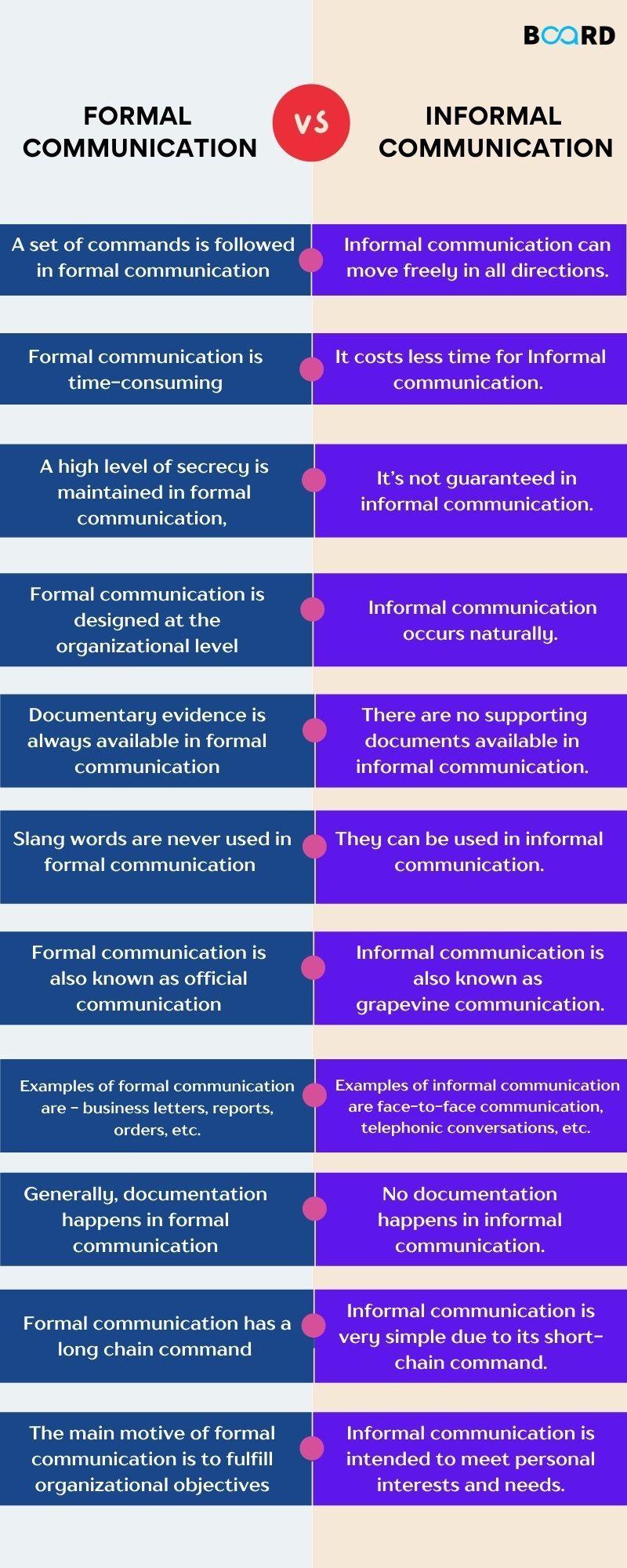
Communication plays a key role in our life, as people interchange their views and thoughts by communicating. It is a core tool that plays an important role even in the growth of the organization.
In an organization, there are two channels of communication - formal and informal. The main difference between the two is that formal communication is backed by predefined channels while there is no such rule for informal communication.
People often confuse these two. To help you understand, we have come up with an article which will clear all your doubts between formal and informal communication.

What is Formal Communication?
The communication in which information flows through proper and pre-defined solutions is referred to as Formal Communication. It follows a hierarchical chain that is generally established by the organization itself.
This type of communication is a must in the workplace because employees are expected to follow formal communication while performing their duties. Some general examples of formal communication are reports, commands, orders, etc.
Types of Formal Communication
1. Vertical
In this type of formal communication, information exchange takes place at different organizational levels. Either the communication takes place from superior authority to subordinate or vice-versa.
It is also classified into two types:
- Bottom-up: Communication flow is from subordinate to superior authority.
- Top-down: Communication flow is from superior authority to subordinate.
2. Lateral or Horizontal
This type of communication takes place between two employees of the same level but working in different departments.
For example, communication that takes place between the Sales Manager and Human Resource Manager.
3. Diagonal or Crosswise
This type of communication takes place between employees of different departments working at different levels.
For example, communication between Salesman and Manufacturing manager.
What is Informal Communication?
Informal communication is multidimensional, it flows freely in the organization without any restraint of predefined channels or routes. It is comparatively very quick and relational.
In organizations it is often called the ‘grapevine’. It is also important for the growth of a company because employees can discuss work-related issues more openly which ultimately saves the company’s time and money.
Some general examples are - chats between team members, a private journal or diary, etc.
Types of Informal Communication
1. Single Strand Chain
The communication in which one person tells something to another who again says something to another person and the process continues.
2. Cluster Chain
In this type of informal communication, one person tells something to some of his friends then they circulate that among their close friends and the process goes on.
3. Probability Chain
In this type, one person randomly chooses some persons and transfers information to them and they also do the same later on.
4. Gossip Chain
This type of communication is very common in an organization, where a person tells something to a group of people then they also spread it further to another group of people till it gets passed to everyone.
Key Differences Between Formal and Informal Communication
- A set of commands is followed for formal communication whereas informal communication can move freely in all directions.
- Formal communication is time-consuming, whereas it costs less time for informal communication.
- Formal communication has its scope restricted within the organization whereas informal communication has no boundary.
- A high level of secrecy is maintained for formal communication, whereas it’s not guaranteed for informal communication.
- Formal communication is designed at the organizational level whereas informal communication occurs naturally.
- Documentary evidence is always available for formal communication whereas there are no supporting documents available for informal communication.
- Slang words are never used in formal communication while they can be used in informal communication.
- Formal communication is also known as official communication and informal communication is also known as grapevine communication.
- Examples of formal communication are - business letters, reports, orders, etc. while examples of informal communication are face-to-face communication, telephonic conversations, etc.
- Generally, documentation happens for formal communication whereas no documentation happens for informal communication.
- Formal communication has a long chain of command whereas informal communication is very simple due to its short chain of command.
- The main motive of formal communication is to fulfill organizational objectives whereas informal communication is intended to meet personal interests and needs.
Wrapping Up
In this blog, we have discussed the differences between Formal and Informal Communication. We sincerely hope that this blog gives you a quick glimpse of the difference between the types of communication.
Most organizations have their channel of formal communication however, informal communication will always be there and is mostly used by the employees at the operational level which is essential for the overall growth of the company.
If you want to upskill your communications skills, do checkout Board Infinity’s English Communication & Soft Skills Course where you can learn at your own pace and get 1-on-1 guidance from the experts.
